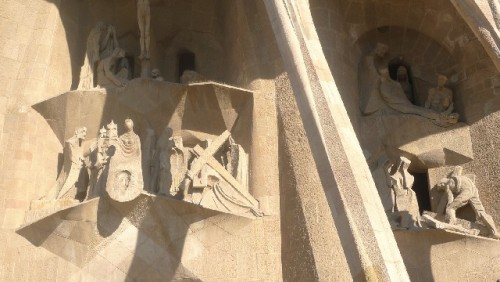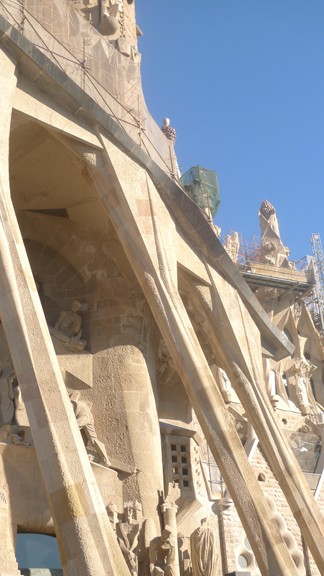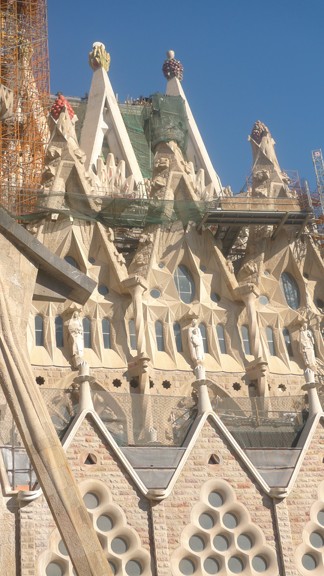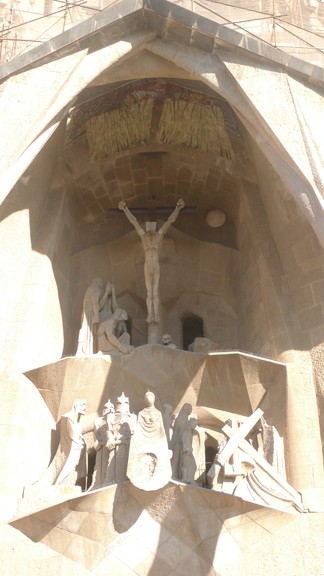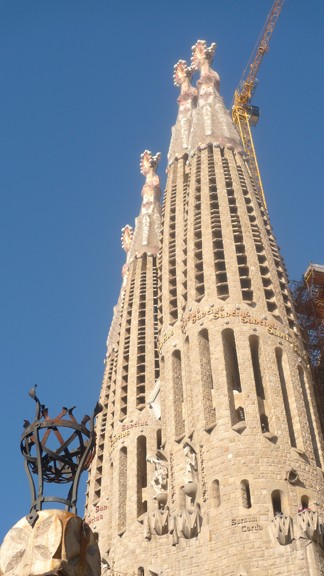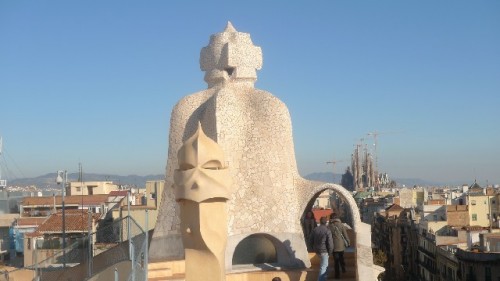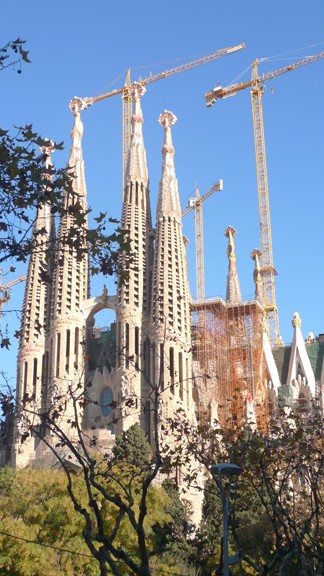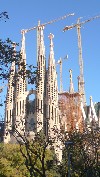Antoni Gaudi's Soaring La Sagrada Familia
An Architectural Vision of Devout Religious Mysticism
By: Mark Favermann - Jan 22, 2010
Antoni Gaudi (1852-1926) was not only an eccentric architect but as he aged, he became more and more devoutly Catholic. His religion and architecture became intwined. The overtly mystical nature of his beliefs informed the design of the buildings and their details. For the last 43 years of his life, Gaudi worked incessantly on his own personal cathedral, La Sagrada Familia in Barcelona. It has become one of the most famous structures in the world.La Sagrada Familia construction was begun in 1882 by a pious, wealthy bookseller named Josep Maria Bocabella. After a trip to Italy he felt that Barcelona needed a cathedral dedicated to The Holy Family. It was to be financed by donations. He purchased a plot of land in a new neighborhood that had been designed by town planner Ildefons Cerda.
Initially, a diocesan architect, Francesc de Paula Villar was put in charge of the project. He designed a neo-Gothic structure. About a year later, soon after the crypt columns were erected, Villar resigned. Antoni Gaudi, then a promising young architect just five years out of architecture school was hired to design the project. With deference to Gothic cathedrals, he redesigned the project entirely.
Initially, a diocesan architect, Francesc de Paula Villar was put in charge of the project. He designed a neo-Gothic structure. About a year later, soon after the crypt columns were erected, Villar resigned. Antoni Gaudi, then a promising young architect just five years out of architecture school was hired to design the project. With deference to Gothic cathedrals, he redesigned the project entirely.
La Sagrada Familia is a cathedral that looks like no other. It is a design unique to itself reflecting Gaudi's vision and mysticism along with his gifts of design and use of materials. Respecting the orientation of the structure and the Villar's crypt, Gaudi envisioned a much more ambitious and grand cathedral than was initially conceived. It was to have five naves, three facades, 18 towers, an exterior ambulatory as a cloister, and other complicated structural elements. Of course, Gaudi would have not been Gaudi without a vast number of symbols integrated into the cathedral structure both literally and conceptually.
Only the crypt, apse, cloister, the Nativity facade, and four towers had been completed at the time of Gaudi's death in 1926. Work on the cathedral continued for the next decade led by Domenech Sugranyes. The Spanish Civil War interrupted the process in 1936. Gaudi's models, drawings and workshop were destroyed by Catalan anarchists.
With many interruptions, work was carried on by architects Francesc Quintara, Isidre Puig Boada, Lluis Bonet i Gari Francesc Cardona. WWII and financial delays made progress halting until 1954. Computer based-design, CAD, was introduced in the 1980's by Lluis Bonet's son Jordi Bonet i Armengol. The stylized sculptures that decorate the facade are by J. Busquets, Etsuro Sotoo and Josep Subriachs.
With many interruptions, work was carried on by architects Francesc Quintara, Isidre Puig Boada, Lluis Bonet i Gari Francesc Cardona. WWII and financial delays made progress halting until 1954. Computer based-design, CAD, was introduced in the 1980's by Lluis Bonet's son Jordi Bonet i Armengol. The stylized sculptures that decorate the facade are by J. Busquets, Etsuro Sotoo and Josep Subriachs.
The cathedral is still under construction with cranes, scaffolding, fences, barricades and construction tarps in view. There is some controversy involved in the most recent and more contemporary construction methods and materials now being used. Many visitors immediately see a difference. And many scholars and architects feel that Gaudi would not have used these ways of working. A cursory view of the structure shows that the original elements of La Sagrada Familia are in contrast especially in the stone coloration to newer elements between the front and back of the structure. The style of the elements are different as well. It is quite noticeable what is Gaudi's work and what is not.
Like most artists, Gaudi was a control freak. He was a total dictator in terms of the construction of La Sagrada Familia. If he was not pleased, he often would have parts of the project torn down and rebuilt, modified, or adjusted to better reflect his vision and design until it was exactly right to him. Due to the fact that a lot of preliminary as well as early drawings and models no longer exist, Gaudi's vision is somewhat open to interpretation. In addition, the major material that Gaudi preferred was the use of irregularly shaped stones. This sets up another challenge to contemporary architects' interpretive abilities.
Since the mid 1950s, since construction was restarted in earnest on La Sagrada Familia, much has been written about the cathedral. Scholars, architects and critics have analyzed, dissected and interpreted the vision, details and elements of the uniquely created structure. In these accounts, there are many stories and even legendary tales. However, two of the most interesting stories are about Gaudi's visionary engineering theory in regard to the structure and his untimely death.
Gaudi was known for his very personal approach to architecture and design. There was a certain totality of form, style and ornamentation for each of his structures. Gaudi spent ten years working on studies for La Sagrada Familia. He developed a creative new method for calculating structural stress. It was based on an innovative model built with cords and small bags of lead shot to reflect the cathedral's structure. An 1:10 outline of the building was drawn on a wood board. This was then hung on the ceiling in a house adjacent to the construction site. Various cords were hung in tension where columns were to be set. The lead pellet sacks were hung from each arch formed by the cords. The arches created were catenary arches. The catenary is the ideal curve for an arch supporting only its own weight. This arch tolerates almost pure compression with no significant bending moment inside the material.
The architect then photographed the model from various angles. When the photos were turned upside down, the lines of tension formed by the cords and weights showed the lines of pressure of the compressed structure. Therefore, gravity revealed the structure. This method of analysis allowed Gaudi to create the many natural forms in his work. This process predated computers and mechanical calculators by decades and demonstrated the master designer's innovative and inspired thinking.
In the later years of his life, Gaudi abandoned secular work to focus his attention on Catholicism and La Sagrada Familia. In the last decade and half of his life, his closest friends and family members began to die in significant numbers. This made the already eccentric architect even more isolated and reclusive. He gave little thought to his attire or grooming. Because of economic conditions in Barcelona, work faltered on La Sagrada Familia. The architect refused to speak to the press or to have his photograph taken. A bit ghoulishly, his last residence was in the crypt of the cathedral.
Not paying attention to traffic while walking from La Sagrada Familia, Gaudi was run over by a tram on June 7, 1926. Due to his unkempt and poor appearance, taxi drivers refused to pick him up and bring him for medical help. Eventually, he was taken to a paupers' hospital in Barcelona where he died three days later. He was 73 years old. His funeral was one of the largest ever held in Barcelona. Referred to by some as God's Architect, he was buried in his religious masterwork.
The hope is that La Sagrada Familia will be completed by 2026 at the 100th anniversary of Antoni Gaudi's death. But, since the Dark Ages, cathedrals have traditionally taken longer to build than often planned. The stops and starts as well as uneven private funding of La Sagrada Familia have added to an unclear construction schedule. Another controversial issue has risen lately as well: a high speed rail tunnel is planned near the cathedral. There is fear of harm being caused by this tunnel to the church's foundation and structure.
La Sagrada Familia is an exceptional, original, complex, symbolic, evocative and often puzzling structure. It is a masterwork that is an expression of a great architect's passion, creativity, mysticism and devout faith. La Sagrada Familia brings visual joy and wonder to all who visit it.


